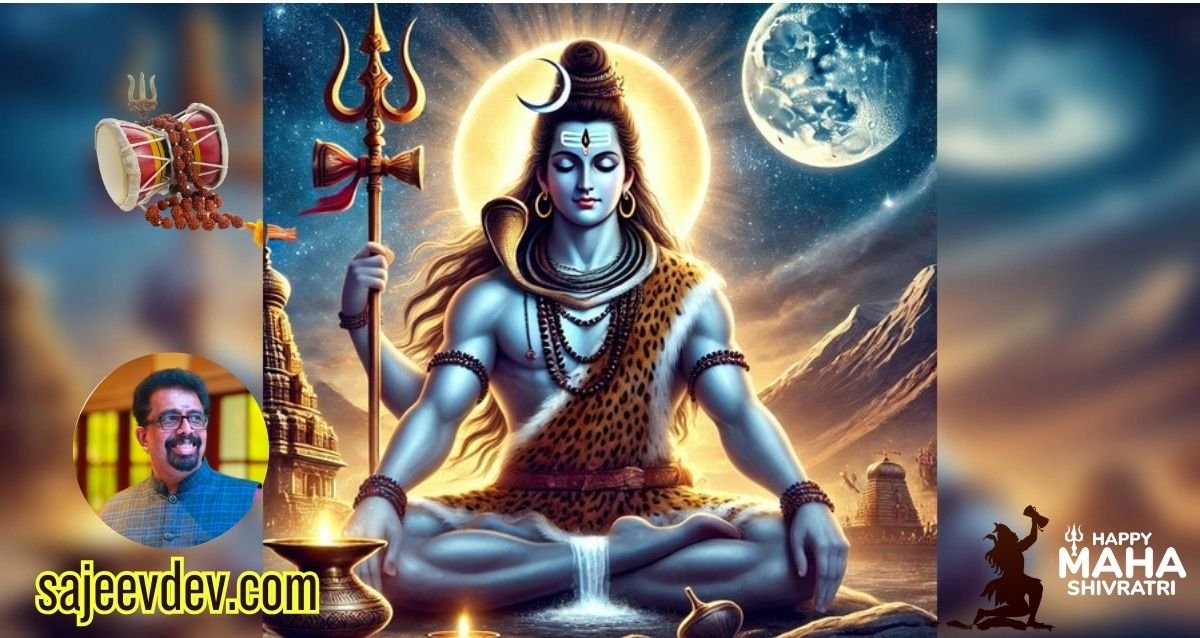Maha Shivaratri?
Maha Shivaratri, commonly known as the “Great Night of Shiva,” is one of the most significant festivals celebrated in Hinduism. This auspicious occasion falls on the 14th night of the waning moon in the month of Phalguna, which typically aligns with February or March in the Gregorian calendar. The festival holds profound meaning and relevance within Hindu mythology, celebrating the divine union of Lord Shiva and Goddess Parvati as well as honoring the cosmic dance of creation and destruction.
In Hindu belief, Maha Shivaratri is a time for devotees to engage in spiritual activities such as fasting, praying, and meditating on Lord Shiva. Many individuals worship Shiva in the form of the Shiva Linga, an icon that represents the energy and potential of creation. This night is dedicated to seeking the blessings of Lord Shiva, who is revered as the destroyer of ignorance and the transformer of the universe. It is believed that those who sincerely worship him on this night will find liberation from sin and attain spiritual growth.
The astronomical alignment of Maha Shivaratri also holds significance; it is said that during this time, the planetary positions favor meditation and introspection. As the night progresses, the atmosphere becomes conducive for spiritual practices, allowing devotees to connect with divine energy on a deeper level. Moreover, this festival transcends mere ritual and offers a cultural context that emphasizes themes of renewal, reflection, and self-discipline.
Ultimately, Maha Shivaratri serves as a reminder for devotees to contemplate the nature of existence, engage in self-improvement, and cultivate harmony within themselves and the universe. As the night unfolds, millions participate in various gatherings, prayers, and chants, reaffirming their faith in Lord Shiva and seeking inner peace.
The Legend Behind Maha Shivaratri
Maha Shivaratri, often referred to as the “Great Night of Shiva,” is steeped in rich historical and mythological significance, particularly in Hindu tradition. One of the most cherished legends associated with this auspicious occasion is the tale of Lord Shiva’s marriage to Goddess Parvati. According to popular belief, Parvati, the daughter of the mountain king Himavan, undertook intense penance to win the heart of Lord Shiva, who was then a recluse engrossed in meditation. Her unwavering devotion and dedication ultimately captivated Shiva, leading to their divine union. This marriage symbolizes the eternal bond between the masculine and feminine energies, reflecting the fundamental balance of the universe.
Moreover, Maha Shivaratri marks the night when Lord Shiva performed the cosmic dance of creation, preservation, and destruction, known as the Tandava. This dance is not merely a performance but a profound representation of the universe’s cyclical nature. Devotees believe that witnessing this celestial dance during the night culminates in spiritual enlightenment and liberation. It is said that during this period, the universe experiences a unique alignment of energies, providing an opportunity for devotees to connect with the divine and enhance their spiritual practices.
In addition to these primary legends, various regional tales also contribute to the celebration of Maha Shivaratri. Some recount the story of a hunter who was transformed into a devotee after unknowingly offering Bilva leaves to the Shiva Linga while pursuing his prey. Each of these stories underscores the significance of devotion and the transformative power of faith. Ultimately, Maha Shivaratri serves as a reminder of the importance of self-discipline, devotion, and the pursuit of spiritual knowledge, encouraging devotees to engage earnestly in prayers and rituals that forge a deeper connection with Lord Shiva.
Rituals and Traditions of Maha Shivaratri
Maha Shivaratri, celebrated in honor of Lord Shiva, encompasses a variety of rituals and traditions that hold deep spiritual significance for devotees. One of the most prevalent practices during this auspicious night is fasting. Devotees often choose to observe a strict fast, which can range from consuming minimal food to complete abstinence from all solid foods. This act of fasting is considered a form of penance and devotion, allowing individuals to purify their minds and bodies. By refraining from worldly pleasures, devotees believe they can attain a deeper connection with Lord Shiva.
Another significant practice observed during Maha Shivaratri is the night vigil, known as “Jaagran.” Devotees often remain awake throughout the night, engaging in prayers, singing bhajans (devotional songs), and chanting mantras dedicated to Lord Shiva. This vigil symbolizes the triumph over ignorance and darkness, as participants strive to remain spiritually awakened while reflecting on the divine qualities of Lord Shiva. Many devotees visit temples during this time, where elaborate rituals, including the offering of milk, honey, and bel leaves, are conducted.
In addition to these practices, devotees often make special offerings to Lord Shiva, which may include fruits, flowers, and various traditional sweets. These offerings symbolize reverence and gratitude towards the deity, serving as a way to seek blessings for personal and communal well-being. Common prayers and chants include “Om Namah Shivaya,” a powerful mantra that encapsulates the essence of seeking oneness with the divine. The recitation of these mantras during the night not only enhances the spiritual atmosphere but also fosters a sense of collective faith among the participants. The combination of fasting, night vigils, and temple visits encapsulates the devout spirit of Maha Shivaratri, reinforcing the unwavering devotion to Lord Shiva that transcends the physical realm.
Astrological Significance of Maha Shivaratri 2025
Maha Shivaratri, celebrated as the night of Lord Shiva, holds profound astrological significance, especially in the year 2025. This festival coincides with specific lunar phases, significantly impacting the energy of the day. In 2025, Maha Shivaratri falls on a day when the moon is in its waxing phase, symbolizing growth and enlightenment. This lunar positioning is believed to enhance spiritual practices, making it an opportune time for devotees to engage in meditation and introspection.
The planetary positions during Maha Shivaratri also play a crucial role in determining the overall auspiciousness of the day. In 2025, several significant celestial alignments coincide, particularly the positioning of Jupiter and Saturn. When paired, these planets foster an environment conducive to spiritual development and transformation. Jupiter, representing wisdom and expansion, combined with Saturn’s discipline and responsibility, creates a unique blend that encourages followers to seek inner strength and fortitude.
The significance of these astrological elements is further enriched by the positioning of the stars. The constellation under which Maha Shivaratri is celebrated adds intricate layers of meaning to this sacred night. In 2025, the movement of celestial bodies is expected to evoke a heightened interest in spiritual pursuits, as the stars align in favor of personal growth. Devotees are encouraged to harness this cosmic energy to enhance their spiritual journeys, focusing on purification and self-realization.
Overall, the astrological relevance of Maha Shivaratri in 2025 outlines a significant opportunity for personal and spiritual enlightenment. By aligning one’s intentions with the celestial energies present on this night, practitioners can deepen their connection with Lord Shiva and experience transformative growth. Such astrological insights emphasize the need for preparation and dedication in worship, as the energies from both the lunar phases and planetary positions are believed to amplify the benefits of spiritual practice during this auspicious time.
The Psychological and Spiritual Benefits of Observing Maha Shivaratri
Maha Shivaratri, known as the Night of Lord Shiva, is not only a significant religious event but also offers numerous psychological and spiritual benefits to those who observe it. Engaging in the rituals and practices associated with this festival fosters a sense of tranquility and peace among devotees. The essence of Maha Shivaratri revolves around devotion, meditation, and self-discipline, nurturing a state of mind that promotes emotional well-being. During this sacred night, many individuals partake in fasting, evening prayers, and night vigils, which collectively provide a unique opportunity for introspection and self-reflection.
One of the primary psychological benefits of observing Maha Shivaratri is the enhancement of self-awareness. The rituals encourage individuals to contemplate their lives, values, and spiritual paths. By spending time in meditation and prayer, devotees often find themselves more in tune with their thoughts and emotions, which facilitates a deeper understanding of their inner selves. This self-awareness can lead to improved mental clarity and a sense of purpose, guiding individuals towards personal growth and transformative insights.
Furthermore, participating in communal activities during Maha Shivaratri reinforces a sense of belonging and connection to others who share similar beliefs and practices. This communal engagement can significantly uplift one’s spirit and promote feelings of unity, which have a profound psychological impact on emotional resilience. The act of joining others in worship is beneficial for mental health, as it provides social support and diminishes feelings of isolation.
Moreover, the spiritual aspect of Maha Shivaratri invites individuals to seek a connection with the divine, which can induce a profound sense of peace and fulfillment. Many practitioners report feelings of liberation and freedom from worldly concerns during this time, primarily due to the focus on spirituality over material desires. This sacred night serves as a reminder of the importance of spiritual pursuits, consequently enhancing the overall well-being of devotees.
Maha Shivaratri Celebrations Around the World
Maha Shivaratri, often referred to as the “Night of Lord Shiva,” is a significant Hindu festival celebrated with fervor across the globe. Each region imbues the celebrations with its unique customs and practices, reflecting the local culture and traditions. In India, the birthplace of this grand festival, participants engage in various rituals, including fasting, night-long vigils, and reciting sacred hymns. Temples dedicated to Lord Shiva are adorned with flowers and lights, and believers gather to offer milk, honey, and water to Shiva Lingas as a mark of respect and devotion.
In Nepal, Maha Shivaratri is a national holiday and attracts thousands of pilgrims to the Pashupatinath Temple, one of the holiest Shiva shrines. Here, devotees engage in chanting, dancing, and making offerings throughout the night. The presence of sadhus, or holy men, dressed in traditional attire adds to the vibrant atmosphere. Their blessings are sought by many, further emphasizing the festival’s spiritual significance in this region.
Beyond the borders of India and Nepal, the festival resonates deeply with the global Hindu diaspora. Cities with significant Indian communities, such as New York, London, and Sydney, host vibrant events and gatherings. Temples often organize special programs featuring devotional songs (bhajans), cultural performances, and community feasts, allowing attendees to celebrate their heritage and strengthen their spiritual connections. In these regions, Maha Shivaratri also serves as an opportunity for interfaith dialogue, showcasing the festival’s universal message of devotion, transcendence, and unity.
The diverse celebrations of Maha Shivaratri highlight its importance not only as a religious observance but also as a cultural phenomenon that connects millions of people across the world through shared beliefs and values. As devotees participate in their unique customs, they collectively honor Lord Shiva while promoting greater understanding among different cultures and communities.
Incorporating Maha Shivaratri into Modern Life
Maha Shivaratri, the significant night dedicated to Lord Shiva, can be harmoniously integrated into contemporary lifestyles, allowing individuals to maintain their spiritual practices while adapting to modern demands. One effective way to observe this festival is through digital worship. With the proliferation of technology, individuals can participate in online pujas and rituals organized by various temples and spiritual organizations. Live-streaming of Maha Shivaratri prayers provides an opportunity for devotees to engage in worship from the comfort of their homes, ensuring that they do not miss the auspicious rituals traditionally conducted during this sacred night.
Additionally, joining online community gatherings has become increasingly popular. Social media platforms and community forums are ideal for connecting with like-minded individuals who share the same devotion. Virtual meet-ups can include chant sessions, sharing of personal experiences, and discussions on the significance of Lord Shiva. These gatherings not only enhance spiritual connection but also nurture a sense of community among participants, allowing them to celebrate Maha Shivaratri even in a digital space.
Furthermore, adapting traditional practices to fit modern schedules is essential for busy individuals who may find it challenging to engage in lengthy rituals. Devotees can opt for shorter, meaningful prayers or light a diya at a convenient time during the day instead of participating in all-night vigils. This approach allows for personal reflection and dedication, preserving the essence of the festival while accommodating varying lifestyles.
By utilizing technology and fostering virtual connections, as well as modifying traditional observances, individuals can effectively incorporate Maha Shivaratri into their modern lives. This ensures that the spiritual significance of the festival remains intact, allowing them to connect with Lord Shiva amidst the hustle and bustle of contemporary living.
Lessons from Maha Shivaratri for Everyday Life
Maha Shivaratri, known as the Night of Lord Shiva, serves as an observance rich in moral and philosophical teachings that resonate with the challenges of modern life. One prominent lesson from this sacred festival is the value of devotion. The act of fasting and engaging in prayer during Maha Shivaratri exemplifies unwavering commitment and dedication, qualities that can be applied to various aspects of our daily lives. By fostering a sense of commitment to our personal goals and responsibilities, we can navigate our challenges with greater resolve and purpose.
Another significant lesson is the notion of sacrifice. Devotees often undertake various forms of self-denial, such as fasting or abstaining from distractions, symbolizing the importance of prioritizing higher principles over immediate pleasures. This idea of sacrifice encourages individuals to reflect on their choices and consider how they can lead more intentional lives. In contemporary society, where instant gratification is common, cultivating the ability to make sacrifices for long-term rewards can foster personal growth and strengthen relationships.
Moreover, Maha Shivaratri highlights the importance of inner strength. The festival emphasizes overcoming darkness and ignorance, a theme that resonates deeply with the personal struggles people face today. By embracing the essence of Lord Shiva, who symbolizes transformation and resilience, individuals can learn to confront their fears and challenges with determination. This inner strength not only empowers individuals to tackle adversity but also inspires them to uplift those around them, creating a supportive community.
Ultimately, the lessons derived from Maha Shivaratri offer a framework for navigating life’s complexities. Integrating values such as devotion, sacrifice, and inner strength into our daily routines can enhance our personal growth and overall well-being while fostering a connected and harmonious society.
The Eternal Significance of Maha Shivaratri
Maha Shivaratri stands as a monumental occasion in Hindu spirituality, emblematic of the eternal relationship between the devotee and the divine. As discussed throughout this blog post, the festival reflects multiple layers of meaning—ranging from the symbolism of creation and dissolution to a celebration of introspection and renewal. It invites devotees to transcend mere ritual and engage in a deeper exploration of their inner selves, ultimately reinforcing their commitment to Lord Shiva.
This night of Lord Shiva is not merely a religious observance; it is an opportunity for individual reflection and personal growth. The significance of Maha Shivaratri emerges from the various practices associated with it, including fasting, night-long vigils, and chanting of mantras. Each ritual serves as a medium to help followers connect profoundly with the essence of Shiva, promoting self-discipline and devotion. This allows for a revitalization of spirit and purpose in one’s life, emphasizing that devotion is not just a one-time act but a continual journey.
Maha Shivaratri transcends geographical boundaries and societal divides, uniting individuals in their shared reverence for Lord Shiva. As adherents partake in the festivities, they are reminded of the cosmic dance of creation and destruction, symbolizing the cyclical nature of existence. This realization encourages a spirit of acceptance and harmony among all beings. The festival cultivates a community of believers who collectively seek enlightenment through shared practices.
Ultimately, Maha Shivaratri invites reflection on the deeper themes of divinity, inner peace, and the transformative power of devotion, urging individuals to evaluate their connection with the divine aspects of their lives. Embracing this spiritual journey not only enriches the experience of the festival but also maps a path toward a more meaningful existence.








